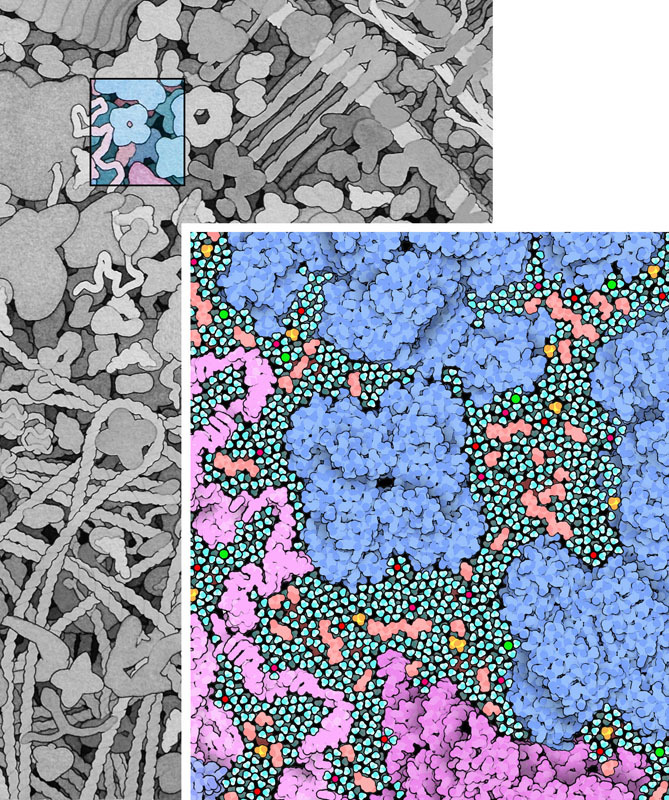Source: The Machinery of Life by David S. Goodsell
When we look closely at an Escherichia coli cell, we observe a bustle of organized activity. This illustration shows a portion of a cell magnified to where individual molecules may be seen. Only the large biomolecules are shown, including proteins, nucleic acids, polysacchandes, and lipid membranes. The spaces in between are filed with water, sugars, nucleotides, amino acids, metal ions and many other small molecules, as shown below (1,000,000 X)

Water and Small Molecules This illustration shows a small portion of the cell at a higher magnification, showing the crowding of small molecules between the larger proteins and nucleic acids. Amino acids, sugars, ATP, and many other small organic molecules are shown in pink. Metal ions are shown in bright red, phosphate ions are in yellow and orange, and chloride ions are in green. Al of the remaining space is filled with water molecules, colored turquoise (5,000,000 X)
Here's the illustration in a larger context:

Cellular Propellers
The small size of Escherichia coli cells has a profound effect on the way that they interact with their surroundings. For them, gravity is not the overwhelming force that it is in our lives. Instead, the constant press of surrounding water is far more important. At small scales, water is not the flowing liquid that it is to us. The surface tension of water is a familiar example: small insects can skate along the surface of a pond, but if we try, the weight of our enormous bodies overwhelms the gentler forces of water and we plunge to the bottom. For cells, these differences are even greater. Cells live in a world of thick, viscous water, almost oblivious to gravity. When moving from place to place, most of their energy is spent trying to push through the gooey liquid, not in lifting their weight up from the ground.
For example, Howard Berg presented a surprising observation in his 1976 lecture "Life at Low Reynolds Number." Escherichia coli cells swim using long corkscrew-shaped flagella, which act like propellers. The cells push their way through the water, typically moving about 30 um/s (30 um is 10 or 15 times the length of the cell). But, when they stop turning the flagella, they don't keep coasting along the way a ship or submarine would. Instead, the surrounding water instantly stops them in less than the diameter of a water molecule.
The flagellar motor is one of the wonders of the biomolecular world. The motor spans the entire cell wall, rotating at speeds of up to 18,000 revolutions per minute. Each rotation is powered by the flow of about 1000 hydrogen ions across the inner membrane. Amazingly, the motor can turn the flagellum in either direction, clockwise or counterclockwise, on demand. When it turns in one direction, all of the flagella on the cell get tangled into a bundle, and together they propel the cell through the surrounding water. If the motor switches direction, however, the flagella separate and flail in different directions, causing the cell to stop and tumble in place.
Bacteria are faced with a serious problem with navigation. Since they are so tiny, they have no way to aim themselves in the right direction. A bacterial cell can't look at a distance and see what direction food lies. Instead, Escherichia coli cells use an effective combination of the swimming and tumbling properties of their flagella. Each cell uses an array of sensors to determine the level of food in the immediate vicinity. Then it swims in a random direction, and measures the level of nutrients there. If the levels are increasing, it keeps swimming in that direction, since things are getting better. If not, the sensory array sends a signal to the flagellar motor, telling it to reverse direction. This causes the cell to tumble, picking a new (and hopefully better) direction to swim. In the rich, watery environment of our intestines, this almost random approach is adequate to keep the cell nourished.

